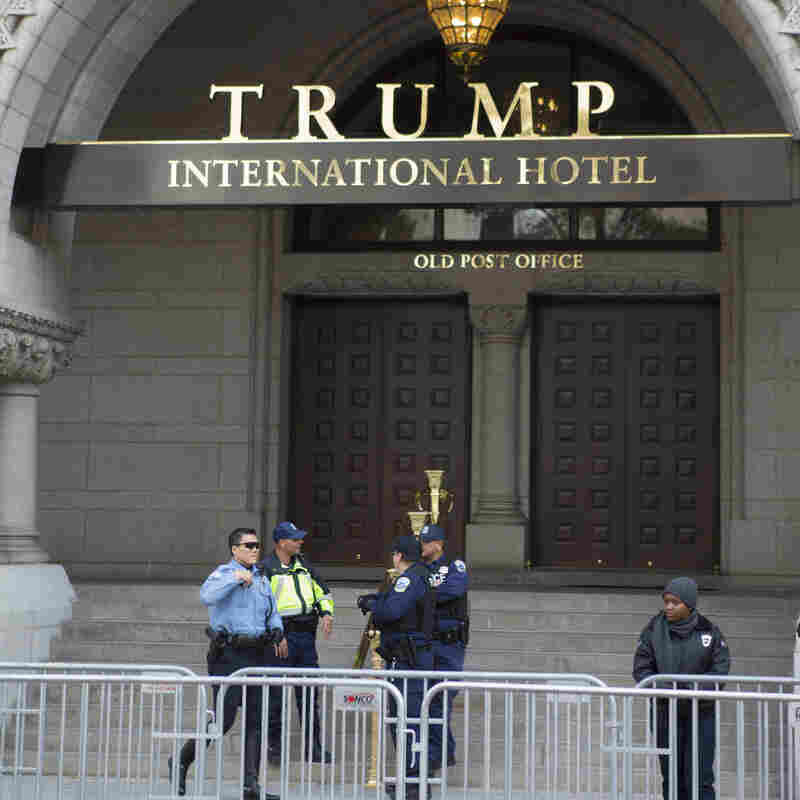Donald Trump Ordered For Deposition In D.C. Hotel Restaurant Case
Hotel employees watch then-Republican presidential nominee Donald Trump following a ribbon cutting ceremony at the new Trump International Hotel October 26, 2016 in Washington, D.C. Chip Somodevilla/Getty Images hide caption
toggle caption
Chip Somodevilla/Getty Images
In five weeks, President Donald Trump’s inauguration parade will roll past his new luxury hotel near the White House. But just over two weeks from now, Trump has to sit down with several lawyers and give a sworn deposition in a lawsuit involving the hotel.
What’s the lawsuit about?
Trump is suing two chefs who bailed out on the hotel after his declaration of candidacy in June 2015 — the speech in which he said Mexican immigrants are “bringing drugs. They’re bringing crime. They’re rapists. And some, I assume, are good people.” Chefs Jose Andres and Geoffrey Zakarian, who had been building signature eateries in the historic Old Post Office building, cited the speech. Trump says they breached their contracts and is seeking $10 million from each of them.
What’s a deposition, and how important is it?
A deposition, unlike a trial, is seeking information, not determining truth. They serve as a basis for trial questions, often to see if a witness’s story changes. Witnesses at depositions have less leeway than trial witnesses in refusing to answer questions.
Veteran Washington lawyer William Taylor III said, “Depositions are taken by the other side for purposes of showing the person being deposed is either a liar or a crook.”
There’s usually no judge present at a deposition. Federal civil-trial rules, which apply in District of Columbia courts, allow depositions as long as seven hours. Trump’s attorneys asked that the upcoming deposition be just two hours; D.C. Superior Court Judge Jennifer Di Toro turned them down.
Trump has already been deposed in the Zakarian case. Trump’s attorneys asked the judge to prevent those questions from being repeated next month. She refused.
Doesn’t Trump have presidential work to attend to?
Clearly yes, but his lawyers didn’t convince Judge Di Toro that it warranted postponing the deposition. They said Trump “is extremely busy handling matters of very significant public importance.” She responded that the restaurant lawyers were working around his schedule, that Trump’s own statements are crucial to the case and, besides, his company Trump LLC had started the legal action.
Have other presidents-elect or presidents been deposed?
Sitting presidents who have been deposed are Ulysses Grant, Gerald Ford, Jimmy Carter and Bill Clinton. Only one of their depositions has major historical significance.
Clinton was deposed in 1998, in a sexual harassment suit by Paula Jones, a one-time government employee in Arkansas. It was the first time he was questioned about former White House intern Monica Lewinsky and their relationship. The deposition fueled investigations by independent counsel Kenneth Starr and House Republicans. In less than a year, House Republicans impeached Clinton. The Senate later voted to acquit him.
Will the deposition be videotaped?
Yes. Trump has been through many depositions, and video of the Zakarian session showed him to be a skilled witness, spare with his words and gestures. In other words, pretty much the opposite of his campaign persona. But whenever the video becomes public, his critics are certain to comb through it, examining both what he said and how he came across — looking for the kind of video moments that quickly flow into social media.














